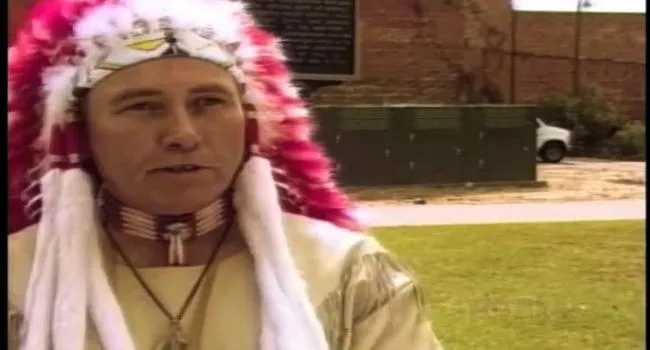The river bears the name of the Catawba Nation, one of the largest tribes in the Southeast at the time of the European arrival. Because of their ability to work with the British and their willingness to fight with them during the French and Indian War, the British government ceded the Catawba the river and the land along its banks,144 thousand acres, a diamond-shaped reservation, that included portions of three current counties, York, Chester and Lancaster. The Catawba held the claim through the early years of the United States, but as the white population increased, the Indian population declined, and by 1840, the Catawba Nation agreed to leave the land Chief Gilbert Blue of the Catawba Nation explains that the land had been leased and the people who had leased it had done so for almost 99 years, in some cases, and some for about a dollar a year. Those landowners wanted title to the land they were using, so they drew up a treaty. This treaty, the Treaty of Nations Ford, led to the most convoluted legal challenges in U.S. history, pitting the Catawba Nation of some 500 living members against over 60 thousand landowners and residents living in northern central South Carolina.
The Catawba Indian Tribal Center sits on all that remains of their former territory, a minute 500-acre reservation in York County, held in trust by the State of South Carolina. The Catawba had relinquished their federally recognized status in the early 1960s, in exchange for the reservation and a small cash settlement, under a now discredited federal policy designed to wean Indian tribes from federal entitlements. Today, those entitlements could provide the Catawba with education and healthcare, and allow them to act as an autonomous government. Chief Blue is encouraging a vote that could restore their federal recognition. The tribe would then continue negotiations with state and federal officials. If they go against Chief Blue's recommendation, the tribe will proceed with the court cases against each individual landowner. When the vote was taken, the tribe had agreed to remain in negotiation to regain their federal recognition. The 1840 treaty had a fatal flaw.
While the Catawba tribe had agreed to sell its land to the State pf South Carolina, there is no record of Congress ratifying the treaty, putting it in direct conflict with the federal Non-Intercourse Act of 1790, the underpinning of all U.S.- Indian policy. It prevents any state from negotiating with any recognized tribal governments without federal approval. The Catawba leadership wants to force a final settlement and gain a four-point plan that would aid the tribe in perpetuity. The four points are: federal recognition, a development fund, acquisition of land, and per capita division among tribal members. Depending on what they would settle for, the projection is about $50 million in cash and with services, around $90 million. The expanded reservation would increase by ten times, to over five thousand acres, and the tribal government would be autonomous. However, Congressman John Spratt asserts that the tribe would be subject to all state and federal environmental laws, as the rest of South Carolina is.
To avoid the extensive number of lawsuits that would be necessary the other way, the Catawba tribe voted unanimously to support the tribal executive committee to pursue the negotiated process until a final settlement of the land claim is reached. The agreement would have to be accepted by the S.C. Legislature, the Governor, the U.S. Congress and the President, but the willingness to compromise was vital. In June 1993, the Governor and the S.C. General Assembly signed the settlement. Congress and the President accepted the agreement with some modifications in October 1993. However, because the agreement grants the State of South Carolina unprecedented jurisdiction over zoning, environmental regulation and criminal justice, the settlement has been severely criticized by American Indian advocates across the nation.
(Produced in 1993 by South Carolina ETV)





